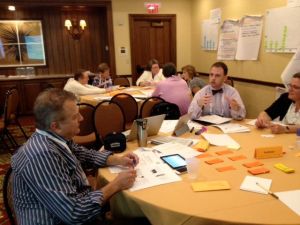By Mary Anne Mather, Managing Editor
TERC’s Using Data for Meaningful Change Blog
Any parent or teacher can identify with the “why” inquisition. For a parent, it’s those moments when your child questions an observed phenomenon like “Why is the sky blue?” You give an explanation, and then the child asks why again…and again. For a teacher, it’s the proverbial student  question, “Why do I need to know THIS?” You explain, and then you hear, “But why is that important to ME?” At times, the whole experience, for certain, can test one’s level of knowledge, not to mention your patience. And yet, we all understand that learning is about inquiry and discovery. Asking “why” should be something to rejoice in! And asking “why” should remain a lifelong learning tool. It doesn’t stop after childhood.
question, “Why do I need to know THIS?” You explain, and then you hear, “But why is that important to ME?” At times, the whole experience, for certain, can test one’s level of knowledge, not to mention your patience. And yet, we all understand that learning is about inquiry and discovery. Asking “why” should be something to rejoice in! And asking “why” should remain a lifelong learning tool. It doesn’t stop after childhood.
I recently came across a list at the Teach Thought website that caused me to reflect again on a very essential phase of the Using Data process—Causal Analysis. Informally, we call it why-why-why. The list posted at Teach Thought, 10 Silent Disruptors Of Student Academic Performance aligned pretty closely to some of the causes that we help teachers to explore during causal analysis in order to justify phenomenon existing in their schools that can be altered, and by doing so, leads to increased student achievement. In fact, we offer a set of cause cards that scaffold the reflection process.
In order to use data well, the why-why-why phase of data analysis through collaborative inquiry is as essential as the air we breathe if, as educators, we are going to get beyond the surface of things and accurately pursue meaningful differences that will impact student achievement. We can have mountains of data, and we can even take a step further and analyze those mountains. But until we connect the dots among multiple data sources, discover specific student learning challenges, and then take the time to ask “why-why-why” in order to verify the root causes of these challenges, selecting solutions is premature.
For sure, the data consulted must reach beyond numbers and test scores because the causes can reside in scheduling, misalignment of curriculum and assessments, mismatched vocabulary between what is taught and what is tested, lack of rigor or teacher content knowledge, low expectations for selected student groups, and more. The causes might be any or all of the 10 disrupters on the Teach Thought graphic. The good news is that verified causes can be addressed, and the results can be astounding!
For a step-by-step description of one why-why-why activity, check out Using Data’s Tip #6, When Analyzing Causes, Ask “Why? Why? Why?”.









